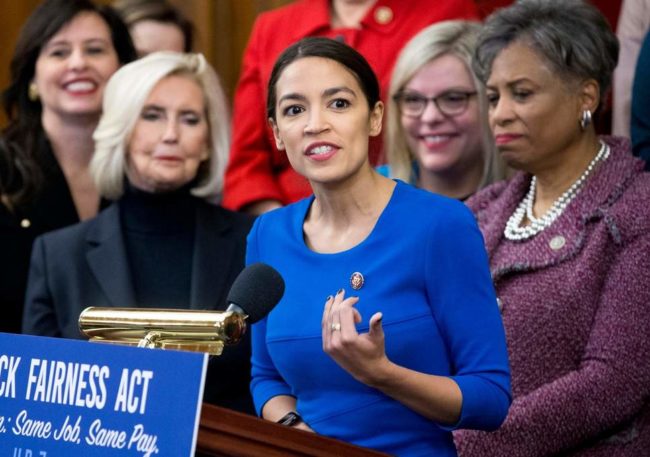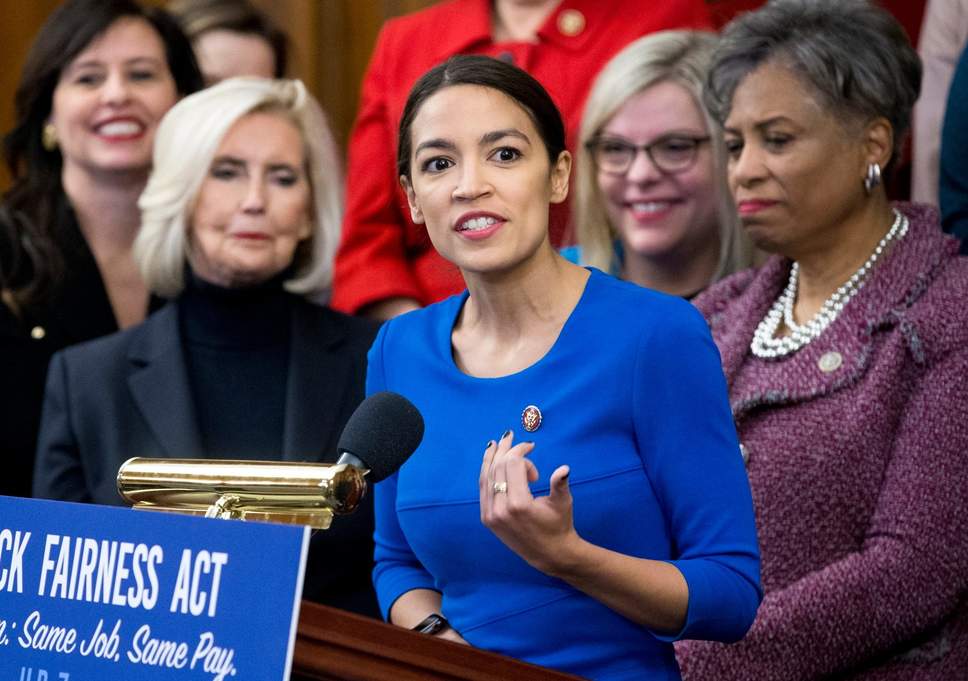
It is out and various media outlets are reporting on what is happening. Rep. Alexandria Ocasio-Cortez and Sen. Ed Markey of Massachusetts have presented their Green New Deal resolution. Many Democrats are happily supporting it, and also of course many Republicans are as well … oh wait, that last bit is not happening, Republicans don’t do science-based issues.
What exactly has happened?
A 14 page non-binding resolution has been presented for a vote. The title of this is as follows …”Recognizing the duty of the Federal Government to create a Green New Deal“.
In other words, this is the first step on the road to doing this. It clearly lays out the precise vision and proposed actions. This is akin to going from the idea of having some sort of cake to having a very specific cake recipe.
What does this Motion Call for?
There is lots of commentary about those in favour and those opposed, but what exactly is it they are in favour of, or opposed to?
Let’s take a look at the actual resolution.
The Opening
It starts out by justifying why this needs to happen. It makes reference to the IPCC report and spells out the consequences of climate change. Interestingly enough, it does also go way beyond climate change. It very clearly addresses the prevailing economic inequality …
… the United States must take a leading role in reducing emissions through economic transformation …
… life expectancy declining while basic needs, such as clean air, clean water, healthy food, and adequate health care, housing, transportation, and education, are inaccessible to a significant portion of the United States population …
… the top 1 percent of earners accruing 91 percent of gains in the first few years of economic recovery after the Great Recession …
…a large racial wealth divide…
…a gender earnings gap …
The Focus of the Resolution
And so we then get to the resolution itself …
… be it Resolved, That it is the sense of the House of Representatives that it is the duty of the Federal Government to create a Green New Deal
(A) to achieve net-zero greenhouse gas emissions through a fair and just transition for all communities and workers;
(B) to create millions of good, high-wage jobs and ensure prosperity and economic security for all people of the United States;
(C) to invest in the infrastructure and industry of the United States to sustainably meet the challenges of the 21st century;
(D) to secure for all people of the United States for generations to come—
(i) clean air and water;
(ii) climate and community resiliency; (iii) healthy food;
(iv) access to nature; and
(v) a sustainable environment; and
(E) to promote justice and equity by stopping current, preventing future, and repairing historic oppression of indigenous communities, communities of color, migrant communities, deindustrialized communities, depopulated rural communities, the poor, low-income workers, women, the elderly, the unhoused, people with disabilities, and youth (referred to in this resolution as ‘‘frontline and vulnerable communities’’)
That basically gets us up to page 6 of this 14 page resolution.
The resolution states that the above are the goals of the “Green New Deal” and that it is a 10 year plan.
Now consider this. Those opposed to this are opposed to the above. You need to seriously ponder over that and remember it when you next stand in front of a ballet box.
But what does it propose we actually do?
The above is just the vision. What the rest of the motion does is to spell out the details of what needs to actually happen to achieve these goals.
It is worth seeing the full breath and depth of this, so here it all is …
(A) building resiliency against climate change-related disasters, such as extreme weather, including by leveraging funding and providing investments for community-defined projects and strategies;
(B) repairing and upgrading the infrastructure in the United States, including—
(i) by eliminating pollution and greenhouse gas emissions as much as technologically feasible;
(ii) by guaranteeing universal access to clean water;
(iii) by reducing the risks posed by flooding and other climate impacts; and
(iv) by ensuring that any infrastructure bill considered by Congress addresses climate change;
(C) meeting 100 percent of the power demand in the United States through clean, renewable, and zero-emission energy sources, including—
(i) by dramatically expanding and upgrading existing renewable power sources; and
(ii) by deploying new capacity;
(D) building or upgrading to energy-efficient, distributed, and ‘‘smart’’ power grids, and working to ensure affordable access to electricity;
(E) upgrading all existing buildings in the United States and building new buildings to achieve maximal energy efficiency, water efficiency, safety, affordability, comfort, and durability, including through electrification;
(F) spurring massive growth in clean manufacturing in the United States and removing pollution and greenhouse gas emissions from manufacturing and industry as much as is technologically feasible, including by expanding renewable energy manufacturing and investing in existing manufacturing and industry;
(G) working collaboratively with farmers and ranchers in the United States to eliminate pollution and greenhouse gas emissions from the agricultural sector as much as is technologically feasible, including—
(i) by supporting family farming;
(ii) by investing in sustainable farming and land use practices that increase soil health; and
(iii) by building a more sustainable food system that ensures universal access to healthy food;
(H) overhauling transportation systems in the United States to eliminate pollution and greenhouse gas emissions from the transportation sector as much as is technologically feasible, including through investment in—
(i) zero-emission vehicle infrastructure and manufacturing;
(ii) clean, affordable, and accessible public transportation; and
(iii) high-speed rail;
(I) mitigating and managing the long-term adverse health, economic, and other effects of pollution and climate change, including by providing funding for community-defined projects and strategies;
(J) removing greenhouse gases from the atmosphere and reducing pollution, including by restoring natural ecosystems through proven low-tech solutions that increase soil carbon storage, such as preservation and afforestation;
(K) restoring and protecting threatened, endangered, and fragile ecosystems through locally appropriate and science-based projects that enhance biodiversity and support climate resiliency;
(L) cleaning up existing hazardous waste and abandoned sites to promote economic development and sustainability;
(M) identifying other emission and pollution sources and creating solutions to eliminate them; and
(N) promoting the international exchange of technology, expertise, products, funding, and services, with the aim of making the United States the international leader on climate action, and to help other countries achieve a Green New Deal;
(3) a Green New Deal must be developed through transparent and inclusive consultation, collaboration, and partnership with frontline and vulnerable communities, labor unions, worker cooperatives, civil society groups, academia, and businesses; and
(4) to achieve the Green New Deal goals and mobilization, a Green New Deal will require the following goals and projects—
(A) providing and leveraging, in a way that ensures that the public receives appropriate ownership stakes and returns on investment, adequate capital (including through community grants, public banks, and other public financing), technical expertise, supporting policies, and other forms of assistance to communities, organizations, Federal, State, and local government agencies, and businesses working on the Green New Deal mobilization;
(B) ensuring that the Federal Government takes into account the complete environmental and social costs and impacts of emissions
through—
(i) existing laws;
(ii) new policies and programs; and
(iii) ensuring that frontline and vulnerable communities shall not be adversely affected;
(C) providing resources, training, and high-quality education, including higher education, to all people of the United States, with a focus on frontline and vulnerable communities, so those communities may be full and equal participants in the Green New Deal mobilization;
(D) making public investments in the research and development of new clean and renewable energy technologies and industries;
(E) directing investments to spur economic development, deepen and diversify industry in local and regional economies, and build wealth and community ownership, while prioritizing high-quality job creation and economic, social, and environmental benefits in frontline and vulnerable communities that may otherwise struggle with the transition away from greenhouse gas intensive industries;
(F) ensuring the use of democratic and participatory processes that are inclusive of and led by frontline and vulnerable communities and workers to plan, implement, and administer the Green New Deal mobilization at the local level;
(G) ensuring that the Green New Deal mobilization creates high-quality union jobs that pay prevailing wages, hires local workers, offers training and advancement opportunities, and guarantees wage and benefit parity for workers affected by the transition;
(H) guaranteeing a job with a family-sustaining wage, adequate family and medical leave, paid vacations, and retirement security to all people of the United States;
(I) strengthening and protecting the right of all workers to organize, unionize, and collectively bargain free of coercion, intimidation, and harassment;
(J) strengthening and enforcing labor, workplace health and safety, antidiscrimination, and wage and hour standards across all employers, industries, and sectors;
(K) enacting and enforcing trade rules, procurement standards, and border adjustments with strong labor and environmental protections—
(i) to stop the transfer of jobs and pollution overseas; and
(ii) to grow domestic manufacturing in the United States;
(L) ensuring that public lands, waters, and oceans are protected and that eminent domain is not abused;
(M) obtaining the free, prior, and informed consent of indigenous people for all decisions that affect indigenous people and their traditional territories, honoring all treaties and agreements with indigenous people, and protecting and enforcing the sovereignty and land rights of indigenous people;
(N) ensuring a commercial environment where every businessperson is free from unfair competition and domination by domestic or international monopolies; and
(O) providing all people of the United States with—
- (i) high-quality health care;
(ii) affordable, safe, and adequate housing;
(iii) economic security; and
(iv) access to clean water, clean air, healthy and affordable food, and nature.
Thoughts?
Rather obviously there are a couple of key points here.
- It is not just about Climate Change, it also addresses social inequality
- It is highly ambitious. The scope is frankly quite breathtaking.
What also needs to be appreciated is that it is not a bill, but instead is simply a non-binding resolution that lays out the details of the vision. What comes next will very obviously be a tough uphill battle to actually execute this and bring it into reality … but given the existing challenges of both social inequality and also climate change, there really is no alternative.
Doing nothing except more of what we already have is not a credible alternative.

There seems to be one glaring omission in this resolution: It fails to provide any guarantee to the unborn that their lives will be protected so that they may live to enjoy the wonderful benefits of the Green New Deal. The Resolution states “…that it is the duty of the Federal Government to create a Green New Deal…to promote justice and equity by stopping current, preventing future, and repairing historic oppression of indigenous communities, communities of color, migrant communities, deindustrialized communities, depopulated rural communities, the poor, low-income workers, women, the elderly, the unhoused, people with disabilities, and youth…” This is beautiful, but they need to add to this list the words “and the unborn.” Because if the Resolution fails to include everyone and bring them along, then isn’t that disingenuous, and don’t we all then have some reason to fear that we too might be left behind someday when expediency demands it? The Green New Deal sets forth a grand dream for mankind, but if some people are left unprotected against the oppression of being killed before they’re born, then what good is any of this to them?